On Becoming a Plant Collector
Posted on Wednesday, August 4, 2021 · Leave a Comment
I’ve always been a gardener. –or at least as far back as I can remember. More recently, say the last 20 years or so, I’ve been a plant collector. What does that mean? If I fall in love with a plant, I want to grow other plants related to it.
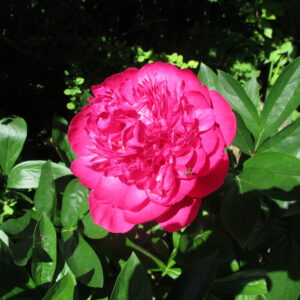
Collector Bill Countryman started out with one peony and eventually collected about 600 varieties
One of the most obsessive collectors I ever met was the late Bill Countryman of Northfield, Vermont. When I interviewed him in the late nineteen nineties he told me that his sister sent him a peony, and although he was in his seventies at the time and not a gardener, he planted it. It bloomed magnificently and Bill fell in love with peonies He decided to grow every type there is.
Bill Countryman bought a chain saw so he could clear his land to plant peonies. He bought a bulldozer to remove the stumps and went to work. When I met him, he had already planted some 300 kinds of peonies, though he continued on, getting more varieties – perhaps as many as 600. He sold them, but mostly he just enjoyed them. He was quite the collector.
I’m not nearly so obsessive. What do I collect? Well peonies, I suppose. But Cindy and I have only 44 peonies. Primroses. Burnets. Persicarias. Wildlflowers. Willows. I have dozens of colors of daylilies, but don’t consider myself a collector of them – they are just nice, reliable plants, but I don’t need one of every kind. Thank goodness for that- there are many hundred.
The burnets are quite a diverse group in the scientific group or genus, Sanguisorba. First I got the one native to New England, Sanguisorba canadensis. It loves wetlands, so I planted it in a weedy, marshy place in part sun/part shade. It thrived, sending flower spikes with bottlebrush flowers 6-feet tall or more. It blooms in late summer or fall, and can still be pretty in late October.
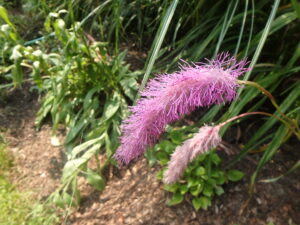
Lilac Squirrel Sanguisorba blossoms are delightful to touch and see
My absolute favorite of these flowers is one called Sanguisorba hakusenensis ‘Lilac Squirrel’. I saw it on-line, and asked all my local garden centers to no avail, so I finally ordered it from Digging Dog Nursery in California. I planted five small plants last year, they wintered over, and are blooming now. The flowers are like pink squirrel tails hanging down from 18-inch flower stems. They make me smile, especially with a name like that.
The littlest of the burnets I grow is one called S. officinalis ‘Little Angel’. It makes a tidy clump of diminutive green leaves edged in white. Each leaf is just half on inch long. The deep red catkin-like flowers are on 6-inch stems that lean or fall over. Now, five years since I bought it, the clump is about a foot across and just 3 inches tall.
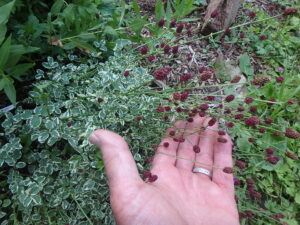
Little Angel is dwarfed by its larger relatives
Little Angel’s bigger cousin in the same genus is one called ‘Tanna’. This is called a miniature, but that is only relative to some of the bigger ones that get 4- to 6-feet tall. It has very tidy 18-inch leaf stems, each with 13 to 17 leaflets in dark green. It makes a tidy mound and has the same dark-red smallish flowers.
Of the large ones that are garden worthy, I have two: probably S. obtusa and S. tenuifolia. The literature, even on-line, is sketchy about identifying these plants and I lost the plant tags long ago. The first, which has reddish-pink tidy small catkin-like flowers needs to be tied up early in July. If not tied up, the flower stems, which get to be over 4-feet long and have 20 or so blossoms per stem, flop over. The other is standing tall and proud right now, but the flowers have not yet opened – and I haven’t staked them.
Why do I collect burnets? I just like them. They can be picked for flower arrangements, but I rarely do. I like seeing them in the garden.
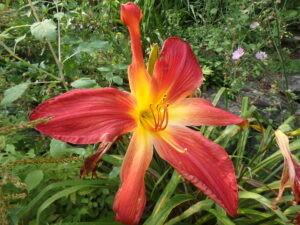
I have dozens of daylilies but don’t consider myself a collector of them
Willows, of course, are more of a problem to collect because of their size, but I do grow at least half a dozen. My favorite is the Salix integra ‘Hakuro nishiki’. It has variegated foliage early in the summer – green and white, and then with pink mixed in for a few weeks. It is colorful and fast growing. Like all willows, it appreciates moist soils but will grow in ordinary garden soil.
‘Hakuro nishiki’ is not a large willow. It seems to top out at about 20 feet in 10 years. I planted three some 20 years ago, ten feet apart, and they created a dense grove. I was able to prune out branches growing into the center, creating a small room where I placed Adirondack chairs. It makes a cool space near my brook to eat lunch on a hot day.
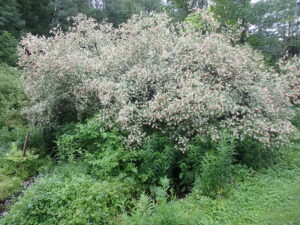
Hakuro Nishiki willows have tri-colored leaves in early summer
The rosemary willow ( Salix eleagnos) is another favorite of mine. It is a small willow, only getting to be about 10 feet tall and wide in 10 years. I love that its leaves look somewhat like leaves of the herb rosemary: narrow and pointy leaves. They are dark green on the top side, gray or silvery on the bottom side. I’ve almost been able to fool people visiting my garden into believing it was really a rosemary plant on steroids– but for the lack of smell. Neither the rosemary or Hakuro nishiki produce any noticeable flowers.
So I encourage you to look for – and collect – plants related to the ones you love. Not every variety will tickle your fancy, but if you discover a few that do, they will make you happy for years to come.







